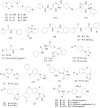Current Research on Antiepileptic Compounds
- PMID: 26610448
- PMCID: PMC6332177
- DOI: 10.3390/molecules201119714
Current Research on Antiepileptic Compounds
Abstract
Epilepsy affects about 1% of the world's population. Due to the fact all antiepileptic drugs (AEDs) have some undesirable side effects and about 30% of epileptic patients are not seizure-free with the existing AEDs, there is still an urgent need for the development of more effective and safer AEDs. Based on our research work on antiepileptic compounds and other references in recent years, this review covers the reported work on antiepileptic compounds which are classified according to their structures. This review summarized 244 significant anticonvulsant compounds which are classified by functional groups according to the animal model data, although there are some limitations in the data. This review highlights the properties of new compounds endowed with promising antiepileptic properties, which may be proven to be more effective and selective, and possibly free of unwanted side effects. The reviewed compounds represent an interesting possibility to overcome refractory seizures and to reduce the percentage of patients with a poor response to drug therapy.
Keywords: antiepileptic compounds; epilepsy; structure activity relationship.
Conflict of interest statement
This work has been supported by Inner Mongolia University for the Nationalities of the Department of Pharmacology. The authors state no conflict of interest and have received no payment in preparation of this manuscript.
Figures













References
Publication types
MeSH terms
Substances
LinkOut - more resources
Full Text Sources
Other Literature Sources
Medical

